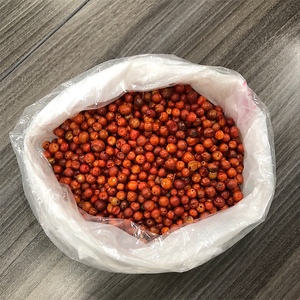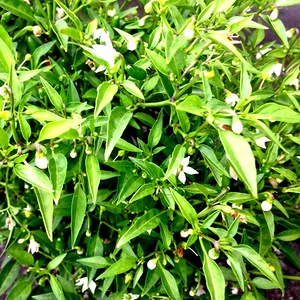


Tepin Chile Peppers
Estimated Inventory, lb : 0
Description/Taste
Tepin chile peppers are very small pods, measuring less than one centimeter in diameter, and have a round to oval shape. The skin is glossy, smooth, and taut, ripening from green to red, with some varieties transitioning into a dark, almost black hue, before turning bright red when mature. Underneath the surface, the flesh is crisp with a fruity aroma, encasing a central cavity filled with very small seeds. Tepin chile peppers have a bright, subtly tangy, and citrus-forward, smoky flavor with an immediate, pungent heat that quickly dissipates.
Seasons/Availability
Tepin chile peppers are available fresh in the fall in the southwestern United States and northern Mexico.
Current Facts
Tepin chile peppers, botanically classified as Capsicum annuum, are tiny, very hot peppers that belong to the Solanaceae or nightshade family. The round, berry-like peppers are the only variety to be native to North America and are believed to be one of the oldest Capsicum annuum species in existence. Tepin chile peppers have intense heat, ranging 50,000-100,000 SHU on the Scoville scale, and the name Tepin comes from the Nahuatl Mexican word for “flea,” which is in reference to the pepper’s small size. The fiery pods are also known by many different names, including Chiltepin and Chile Tepin, and the peppers are a variety of bird pepper, which is a name derived from bird’s widely consuming the pepper in the wild. Tepin chile peppers are not commercially cultivated and are only found growing naturally or in home gardens. Decreed the official “native pepper” of Texas in 1997, the small peppers have become embedded in southwestern culture and are a gastronomic symbol of Sonoran and Tex-Mex cuisine.
Nutritional Value
Tepin chile peppers are a good source of vitamins A, C, and K, as well as beta-carotene and potassium. The small peppers also contain large amounts of iron, magnesium, and capsaicin, which is a chemical compound that triggers the brain to feel the sensation of heat or spice. Capsaicin has been shown to provide anti-inflammatory benefits and has been used topically in traditional indigenous medicine to reduce pain.
Applications
Tepin chile peppers can be used in their young, green state to make tangy, spicy vinegar, but the pods are most often utilized when mature and are dried in the sun for extended use. Once dried, the peppers can be ground into powder or flakes and used as a spicy seasoning for soups, stews, chilis, and egg-based dishes. The seasoning can also be sprinkled over ice cream, used as a preservative for meat, or incorporated into sauces, marinades, and dry rubs. In addition to seasoning, Tepin chile peppers can be added to soft cheeses, salsas, and oils, or pickled with spices and salt to create a tangy, spicy condiment. In Sonora, Mexico, Tepin chile peppers are commonly used in aguachile, which is a ceviche typically made with shrimp, fresh herbs, onions, cucumber, and lime juice. They are also a popular ingredient used in flavoring Tex-Mex cuisine in the southern United States. Tepin chile peppers pair well with asparagus, cucumber, tomatoes, herbs such as cilantro, mint, and Mexican oregano, polenta, meats such as pork, beef, and poultry, seafood, and rice. The fresh peppers will keep up to one week when stored whole and unwashed in the refrigerator. Dried peppers will keep for at least one year when stored in a cool, dry, and dark place.
Ethnic/Cultural Info
In northern Mexico, the Tepin chile pepper’s heat is locally known in Spanish as arrebatado, meaning “rapid” or “violent,” referring to the pepper’s immediate spice that quickly diminishes. The small and spicy chile has a long, rich history along the United States and Mexico border as many of the plants are found growing naturally on nearby mountainsides and in canyons, living for over fifty years. In these desert regions, Tepin chile peppers are highly used in traditional dishes, medicines, and folklore of the Opatas and Yaqui people of Sonora in northern Mexico, and the O'odham people of southern Arizona. The wild-harvesting traditions are still practiced in the modern-day, where communities camp near the Tepin chile pepper plants and spend days harvesting the pods by hand. Some harvesters have recorded that it can take a day and a half to harvest approximately two gallons of peppers. With their painstaking harvest and variability in heat depending on growing conditions, Tepin chile peppers are expensive in the market and are considered a specialty variety. In northern Mexico, dried and ground Tepin chile peppers are one of the most common spices found on tables at restaurants and are used as an everyday seasoning.
Geography/History
Tepin chile peppers are native to regions in the southwestern United States and northern Mexico and have been growing wild since ancient times. The presence of the small peppers has decreased over time due to weather patterns combined with habitat destruction, and there are less than fifteen natural habitats located in the United States where the plants still grow naturally. Many of these areas are found within protected National Parks in Arizona. Tepin chile peppers can also be found in northern Mexico, especially in Sonora, and are harvested from the wild and sold through local markets. In addition to growing wild, some Tepin chile pepper plants have been successfully grown in home gardens in Texas, Arizona, and Mexico.
Recipe Ideas
Recipes that include Tepin Chile Peppers. One
| Tarladalal |
|
Quick Garlic Ginger Pickles with Tepin Pepper |
| Morgan Ranch |
|
Chili Tepin Hot Sauce |
| Honest Food dot Net |
|
Homemade Chiltepin Hot Sauce |
| Eats Well with Others |
|
Tepin Chile Chicken and Waffles |










